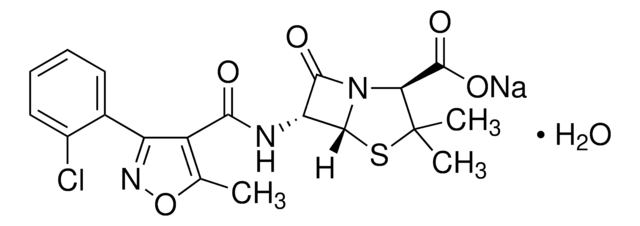D219
Monoclonal Anti-Dihydropyridine Receptor (α2 Subunit) antibody produced in mouse
clone 20A, ascites fluid, buffered aqueous solution
Synonym(e):
Anti-CACNA2, Anti-CACNL2A, Anti-CCHL2A, Anti-LINC01112, Anti-lncRNA-N3
About This Item
Empfohlene Produkte
Biologische Quelle
mouse
Qualitätsniveau
Konjugat
unconjugated
Antikörperform
ascites fluid
Antikörper-Produkttyp
primary antibodies
Klon
20A, monoclonal
Form
buffered aqueous solution
Mol-Gew.
antigen 143 kDa (reduced)
antigen 220 kDa (non-reduced)
Speziesreaktivität
rat, mouse, rabbit, guinea pig
Methode(n)
immunohistochemistry (frozen sections): 1:500
western blot: 1:500
Isotyp
IgG2a
UniProt-Hinterlegungsnummer
Versandbedingung
dry ice
Lagertemp.
−20°C
Posttranslationale Modifikation Target
unmodified
Angaben zum Gen
mouse ... Cacna2d1(12293)
rat ... Cacna2d1(25399)
Verwandte Kategorien
Allgemeine Beschreibung
Spezifität
Immunogen
Anwendung
Western Blotting (1 paper)
- immunofluorescent histochemistry
- surface plasmon resonance binding
- immunohistochemistry (IHC)
- immunoblotting
Biochem./physiol. Wirkung
Physikalische Form
Sonstige Hinweise
Haftungsausschluss
Sie haben nicht das passende Produkt gefunden?
Probieren Sie unser Produkt-Auswahlhilfe. aus.
Lagerklassenschlüssel
10 - Combustible liquids
WGK
nwg
Flammpunkt (°F)
Not applicable
Flammpunkt (°C)
Not applicable
Persönliche Schutzausrüstung
Eyeshields, Gloves, multi-purpose combination respirator cartridge (US)
Hier finden Sie alle aktuellen Versionen:
Besitzen Sie dieses Produkt bereits?
In der Dokumentenbibliothek finden Sie die Dokumentation zu den Produkten, die Sie kürzlich erworben haben.
Unser Team von Wissenschaftlern verfügt über Erfahrung in allen Forschungsbereichen einschließlich Life Science, Materialwissenschaften, chemischer Synthese, Chromatographie, Analytik und vielen mehr..
Setzen Sie sich mit dem technischen Dienst in Verbindung.







